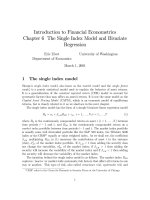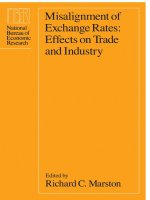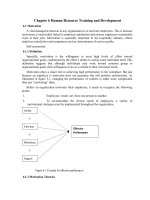Chapter 6 Foreign Exchange Markets and Exchange Rates 2
Bạn đang xem bản rút gọn của tài liệu. Xem và tải ngay bản đầy đủ của tài liệu tại đây (1.04 MB, 51 trang )
Chapter 6
Foreign Exchange Markets
and Exchange Rates
Nguyen Thi Vu Ha MA.
Faculty of International Economics
UEB - VNU
Introduction
Goods and services
Supply
Sellers
Demand
Buyers
2 nations
Currencies
Problems
Introduction
Problems
Buyer's?
Which
currency is
paid?
How
currencies are
transferred?
Seller’s?
Others?
How do we
calculate the
value of a
currency?
Learning Goals
Understand the meaning and functions of
the foreign exchange markets (FX)
Define spot, forward and cross rates and
deals with foreign exchange risks, hedging,
and speculation;
Understand the exchange rates
determination
Contents
1. Definition, characteristics, participants
and functions of foreign exchange
market
2. Exchange rates: Definition,
classification and the equilibrium
exchange rates.
3. Factors that Influence Exchange Rates
4. Arbitrage, hedging and speculation in
foreign exchange market
Foreign Exchange Market - Definition
• What is the FX market?
– The foreign exchange market is the market in
which foreign currencies or foreign exchange
are traded/ converted
• What types of foreign exchange?
– International settlement instruments (checks,
bonds, bills of exchange…)
– Foreign currencies
– Special drawing rights – SDRs
– Gold at International standard
Foreign Exchange Market - Definition
• What is the FX market for the US dollar?
– The FX market for US dollar is comprised of all
the locations where the dollars are bought and
sold for other currencies.
– These monetary centers are connected
electronically and are in constant contact with
one another, thus forming a single international
foreign exchange market.
• Why do we need to exchange one currency
for another?
– To pay for goods and services activities
– To make profit and speculations
FX Market - characteristics
• Huge trading volume
• Continuous operation and geographical
dispersion
• The variety of factors that affect
exchange rates
• Exchange rate between currencies are
equalized
• …
Global Foreign Exchange Market Turnover
in the Traditional Foreign Exchange Market
Daily averages in April in billions of US dollars
at April 2007 exchange rates
Which is the
next largest
market in the
world?
Which
organizations
or institutions
set rules or
supervise FX?
Source: BIS
Choose the right words?
Individual trades of $200 – 500 million are not
uncommon/common
Quoted prices change as often as 20 times a(n)
minute/hour
It is estimated that the world’s most active
exchange rates can change 18,000 times a
day/week
Most of these foreign exchange transactions take place
through debiting and crediting bank accounts rather
than through actual currency exchanges. True of False?
Geographical dispersion and
Continuous operation
Amsterdam
Hamburg
Brussels
Dusseldorf
London
Frankfurt
Toronto
San
Francisco
Chicago
New
York
Zurich
Paris
Basel Rome
Madrid
Vienna
Tokyo
Hong Kong
Mexico
City
Bombay
Singapore
Sydney
Rio de Janiero
São Paulo
Melbourne
Most traded currencies
Currency distribution of reported FX market turnover
Rank
Currency
1
2
3
4
5
6
7
8-9
8-9
10
United States dollar
Euro
Japanese yen
Pound sterling
Swiss franc
Australian dollar
Canadian dollar
Swedish krona
Hong Kong dollar
Norwegian krone
Other
Total
ISO 4217 code
% daily share (April 2007)
USD ($)
EUR (€)
JPY (¥)
GBP (£)
CHF (Fr)
AUD ($)
CAD ($)
SEK (kr)
HKD ($) Why not
100%
NOK (kr)
86.3%
37.0%
17.0%
15.0%
6.8%
6.7%
4.2%
2.8%
2.8%
2.2%
19.2%
200%
The varietydestabilization
of factors
that
affect
of coalition
governments in Pakistan and
trade deficits may
exchange
rates
Thailand can negatively affect
have a negative
the value of their currencies
impact on a nation's
currency
Economic
factors
• Economic
policy
• Economic
conditions
• Economic
indicators
Political
conditions
• Internal
conditions
• Regional
conditions
• International
conditions
• Events
"Buy the
rumor, sell
the fact”
Market
psychology
• Market
psychology
• Trader
perceptions
FX Market - Functions
to transfer funds or purchasing power from
one nation and currency to another
Through electronic transfers and
Internet
FUNCTIONS
the credit function
Credit is usually needed when goods are in
transit and also to allow the buyer some
time to resell the goods and make the
payment (60 days or 90 days after sight)
to provide the facilities for hedging and speculation
Today, about 90 percent of foreign
exchange trading reflects purely
financial transactions and only
about 10 percent trade financing.
Through financial instruments:
spot, forward, future, option and
swap contracts
Participants in FX markets
• Who are participants in
foreign exchange
markets?
central
banks
brokers
commercial banks
traditional users as tourists,
importers, exporters,
investors, and so on…
Participants in foreign exchange
markets
• Those needing currency
to fund transactions
– Purchase of goods
– Tourism
– Foreign investment
central
banks
brokers
commercial banks
Level 1
traditional users as
tourists, importers,
exporters, investors,
and so on…
Participants in foreign exchange
markets
• Commercial banks
– Serve as the
clearinghouses for
currency exchange
central
banks
brokers
Level 2
commercial
banks
Level 1
traditional users as tourists,
importers, exporters, investors,
and so on…
Participants in foreign exchange
markets
• Foreign exchange
brokers
central
banks
– Clearinghouse for
surpluses and shortages
between the commercial
banks
Level 3
brokers
Level 2
commercial banks
Level 1
traditional users as tourists,
importers, exporters, investors,
and so on…
Participants in foreign exchange
markets
• Central banks
– Buyer or seller of last
resort in the foreign
exchange markets
L4
central
banks
Level 3
brokers
Level 2
commercial banks
Level 1
traditional users as tourists,
importers, exporters, investors,
and so on…
Foreign Exchange Rates (ER)
Definition
Quotations
Types of ER
Factors that
influence ER
ER – definition
An exchange rate is the price of one currency
in terms of another
• For example, an exchange rate of 19000
Vietnamese Dong (VND) to the United
States dollar (USD, $) means that VND
19000 is worth the same as USD 1.
• E(VND/USD) = 19000
ER – quotations
Direct quote
• 1 foreign currency unit = x home currency units
Indirect quote
• 1 home currency unit = x foreign currency units
American terms
• dollars per other currency unit
European terms
• other currency units per dollar
ER – quotations
• For example, suppose that the pound is trading at 2.0000
dollars per pound or .5000 pounds per dollar. Which is the
exchange rate between the dollar and the pound (the pound
is the home currency)?
Which do you choose?
Direct
quote
2.0000
.5000
Indirect
quote
2.0000
.5000
American
terms
2.0000
.5000
European
terms
2.0000
.5000
ER – direct quotations
base currency (unit currency, transaction currency)
E (VND/USD) = 19150 1 USD = 19150 VND
quote currency (price currency, payment currency, term currency)
The quote currency is thus the numerator in the ratio, and
the base currency is the denominator.
The value of the base currency (denominator) is always 1
ER – direct quotation
if the home currency is
strengthening (i.e.
appreciating) then the
exchange rate number
decreases
If the foreign currency is
strengthening, the
exchange rate number
increases and the home
currency is depreciating
When E (VND/USD) rises, the dollar strengthens/loses and
the dong strengthens/loses its value









